Categories
- Argentina
- Chile
- Antarctica
- Easter Island
- Falklands (Malvinas)
- Bolivia
- Peru
- Uruguay
- Paraguay
- Brazil
- Venezuela
- Colombia
- Ecuador
- Galapagos
- Panama
- Costa Rica
- Cuba
- Nicaragua
- Honduras
- El Salvador
- Guatemala
- Belize
- Mexico
- Latin American Xmas
Pages
- Street Art of Buenos Aires
- A week in Buenos Aires
- The Jesuit Missions in South America
- Contact Us
- Map of Central America
- First week in Latin America – October 2009
- Home Page
- Map of South America
Archives
- October 2011 (3)
- September 2011 (9)
- August 2011 (10)
- July 2011 (7)
- June 2011 (6)
- May 2011 (11)
- April 2011 (10)
- March 2011 (4)
- February 2011 (5)
- January 2011 (6)
- December 2010 (6)
- November 2010 (4)
- October 2010 (8)
- September 2010 (5)
- August 2010 (7)
- July 2010 (5)
- June 2010 (6)
- May 2010 (6)
- April 2010 (7)
- March 2010 (6)
- February 2010 (9)
- January 2010 (4)
- December 2009 (8)
- November 2009 (5)
- October 2009 (2)
Earthquake in Chile
27th February 2010
We got a hell of a fright at 3.30 this morning when our 100 year old hostel in Santiago de Chile started shaking and a big bit of the wall fell on the bed where Jeff had been lying. It was an 8.8 earthquake. The hostel owner was very good and got us all out safely.
.
We waited a few hours in the park nearby before we could find another accommodation. We later saw that the wall on the floor above us had fallen out completely, leaving the beds exposed. Its chaos in Santiago now and we are stuck here for a couple of days as no buses or planes are going anywhere.
.
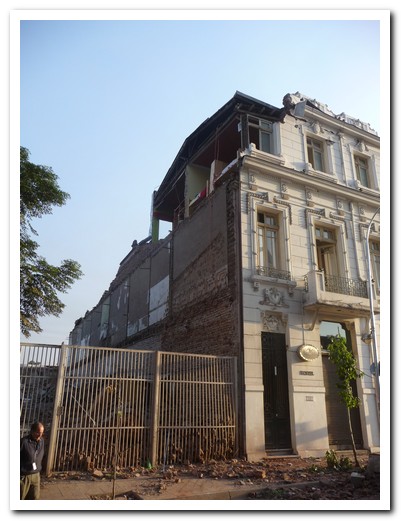
The outside of our hostel (there was a vacant lot next to it)
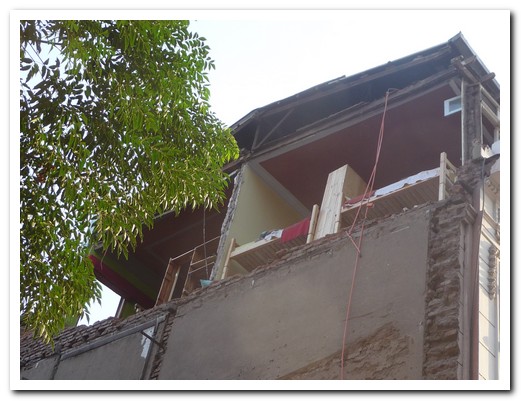
Beds exposed on the top floor

The house next door lost a wall

Rubble outside the hostel

A piece of wall fell out into our room ...

... leaving a big mess
Valparaíso
27th February 2010
Valparaíso (Valpo as the locals call it) is a World Heritage city built on several steep hills around the harbour. The mansions and brightly coloured corrugated iron houses all seem to have been built on top of each other.
.
To access the top there are many twisting stairways and a maze of alleys but the best way is to ride one of the more than 100 year old funiculars that rattle up and down the hillsides for as little as 60 cents. It is first necessary to enter through a heavy, old fashioned turnstile operated by a foot pedal.
.
Sadly, many of the old ascensores no longer operate and lie abandoned with their carriages still attached to the cable, one at the top of the hill and the other at the bottom.
.

The funicular carriage coming down pulls the other one up

The huge wheel to pull up the cable

Foot operated turnstyle to access the lifts

Jumble of houses on the hillsides

Mural of Valpo harbour

No longer operating

Row of coloured houses

Mural of funicular

Wooden structure supports the track

The farmers´s market is the oldest in Chile


Part of an outdoor art gallery



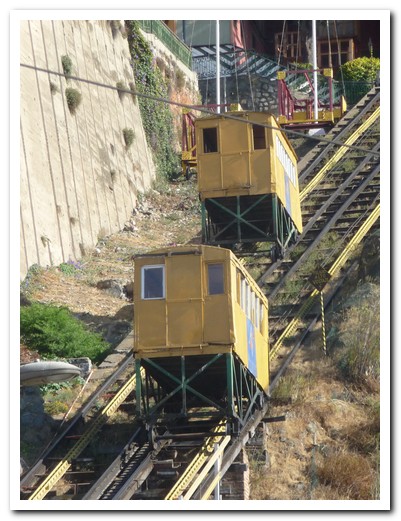

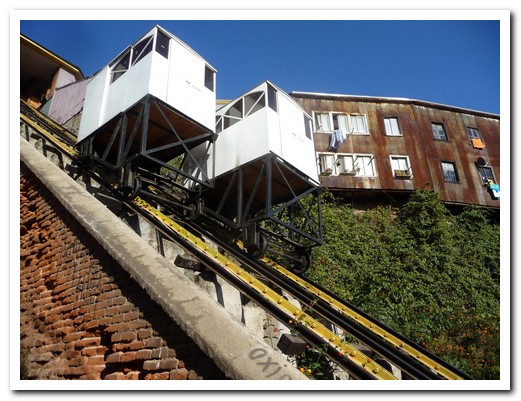

A 300 meter long underground tunnel leads to this elevator

Palm native to central Chile produces delicious honey
Viñas de Chile
26th February 2010
Most of the wine of Chile is produced in the valleys within a few hours drive of Santiago. 85% of Chile´s wine is exported, and almost all the good stuff. If you want to try excellent Chilean wines you need to go to the wineries.
.
So we headed south to began our tasting in the Maule Valley around Talca, then moved on to the Colchagua Valley centered on Santa Cruz. These valleys are famous for their red wines, especially Cabernet Sauvignon and Carménère. The vines were full of fruit, ready to be picked in about 2 weeks. One winery (Viña Gillmore) started the tour with a tasting the various grape varieties growing in the vineyard, before moving on to sample the finished wines.
.
The Casablanca Valley, northwest of Santiago, produces some excellent white wines. We tasted some great Sauvignon Blanc and Chardonnay as well as a beautiful Pinot Noir at Viña Casas del Bosque.
.
.

Viña Gillmore, near Talca (Maule Valley)

The grapes are starting to ripen in February

Tasting the grapes in the vineyard

Viña Balduzzi in San Javier (Maule Valley)

Church at Santa Cruz

Colonial building in Santa Cruz

Entrance to Viña Viu Manent (Colchagua Valley)

Viña Viu Manent offers horse drawn carriage tours

Viña Las Niñas - all female winery in the Colchagua Valley

Viña Casas del Bosque (Casablanca Valley)
Easter Island (Isla de Pascua)
18th February 2010
We made a last minute decision to visit Easter Island during their annual Tapati Rapa Nui Festival, and on arrival became caught up in a parade of half naked, decorated islanders.
.
To see for ourselves those giant statues (Moai) was really something, and on a visit to the volcano quarry many unfinished heads could be seen scattered about. There are some 800 around the island ranging from 2 metres to 21 metres high.
.
The laid back capital Hanga Roa has no high rise buildings and it is not unusual to see people riding horses through town. The fat fried empanadas stuffed with fresh tuna and cheese were irresistible.
.

Moai at dawn

Hanga Roa town - main street

Tapati Rapa Nui festival body painting competition





Sunset over the water

All the Moai (except 7) faced inland towards the villages

Once the eyes (made of coral) were in place, the Moai became alive

Moai abandoned at the quarry

Volcano quarry where the Moai were carved

The largest Moai at 21 meters high, lies half finished

The statues were carved leaving a keel which was later removed

Still unfinished





Cutting made in the rim of the volcano to get the statues out



The red top knots were a later style

Rear view - the platforms they sat on were altars


The crater of one of the many extinct volcanoes on the island

Petroglyph on a rock at Orongo ceremonial village






Could The Incas have made this platform?

All the Moai were destroyed in the 19th centuary, not all have been restored

Folk dancing reminds us that this is Chile after all
Santiago
11th February 2010
Santiago is a pleasant city to spend a few days, with some leafy cobbled streets and interesting buildings. We were able to catch some street theatre, where a giant wooden puppet performed for the crowds.
.
There are vineyards to the south, easily accessable by public transport. We visited Concha y Toro as we have sampled a lot of of their Casillero de Diablo wines in Australia. We like the legend that the devil lives in the cellar. The owner started the rumour many years ago in order to stop his workers from stealing his best wines, worked too.
.

Downtown Santiago

Statue of the Virgin on Cerro San Cristobel

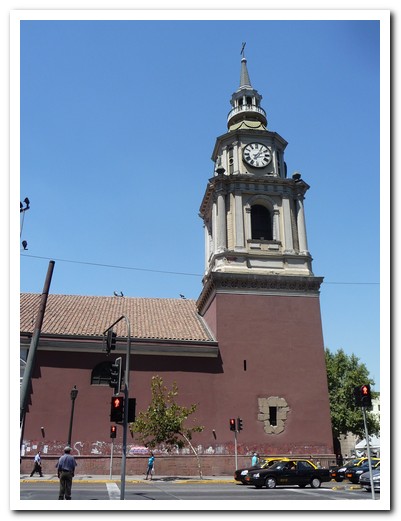







The little giant (puppet)


Concha y Toro vinyard

Grapes for the best wines are grown here

El diablo in the cellar
Stanley
10th February 2010
Our last night was spent at pretty Stanley. We will have fond memories of the Falklands. Everywhere we stayed, the British hospitality was warm and welcoming. The “full English” breakfasts were a real treat. Falkland Islands Holidays arranged our trip. Everything went so smoothly.
.
The islands are privately owned, where sheep and cattle live side by side with the wildlife. The owners have allowed tourists to come and stay and share it all.
.
The pilots flying between the islands on a daily basis in such winds are real legends. They will still fly when the wind is too strong for the ferry to sail. The scariest part however, was the weigh in before boarding the flight.
.

Stanley from the air

Wreck of an old sailing ship

Memorial for the 1982 Falklands War

The Governors Residence

The Falklands Island Company once owned the Islands

Stanley looks very British

Anglican Church

Catholic Church

The full English

There are many ship wrecks at Stanley
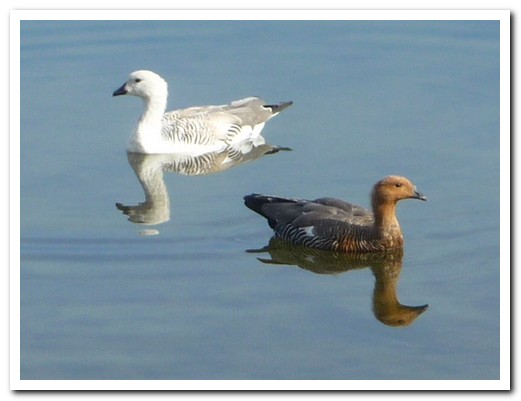
Calm weather for a change

Seagull and reflection
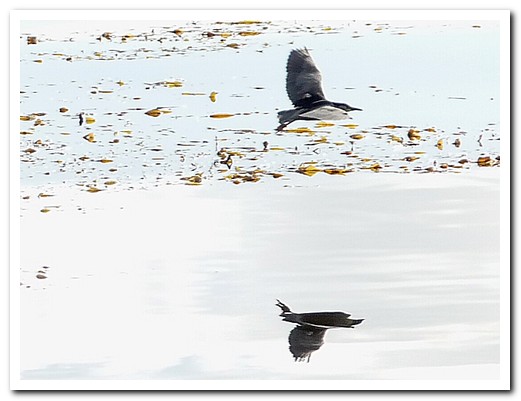
Flying duck reflected in the calm waters
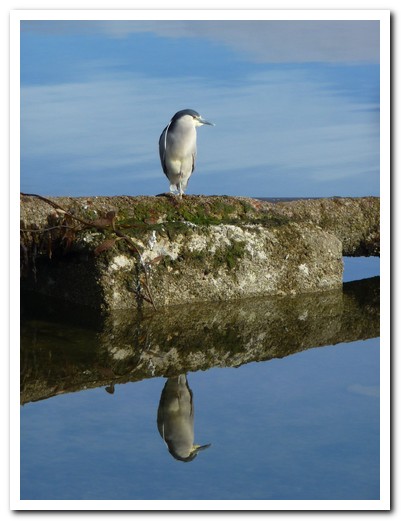
Volunteer Point
09th February 2010
The highlight of our trip to the Falklands was the night we stayed in the Wardens house at Volunteer Point (Map of Falklands), where a large colony of some 800 breeding pairs of King Penguins live all year round. It was a two and a half hour drive over rough terrain from Stanley. Colonies of Gentoo and Magellan Penguins also live side by side with the grazing sheep.
.
Derrick and Trudy are doing an amazing job as Wardens and welcomed us into their home as family. Once the day tourists left, the Penguins were ours. They were not shy and if we stood still, they would come right up close for a better look. We saw penguins on eggs, small babies still being watched over by parents, fluffy fat brown chicks in creches and moulting juveniles, even mating penguins.
.
We have adopted a King Penguin and called him Eduardo. (Adopt a Penguin)
.
.

Eduardo - our adopted King Penguin

King protecting chick


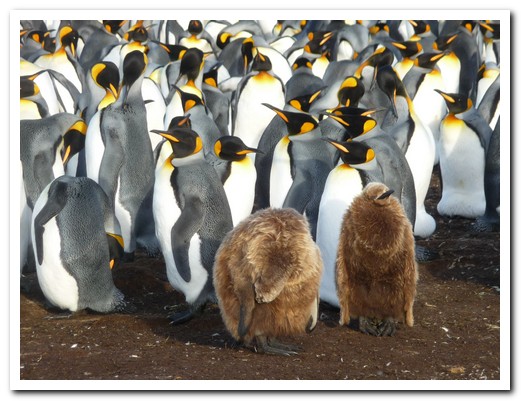
Chicks - brown balls of fluff



Fat juvenile King

Moulting Kings




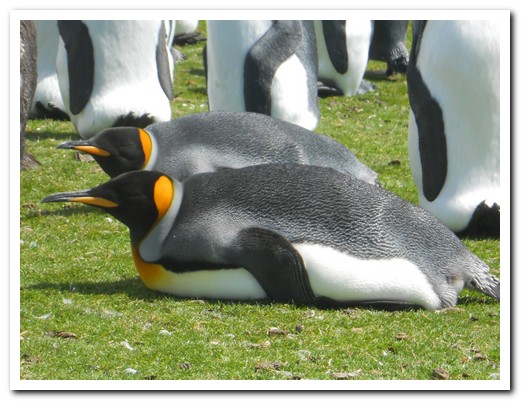



Gentoos going fishing

Gentoo in the surf

Gentoo coming out of the surf

Magallans at dawn
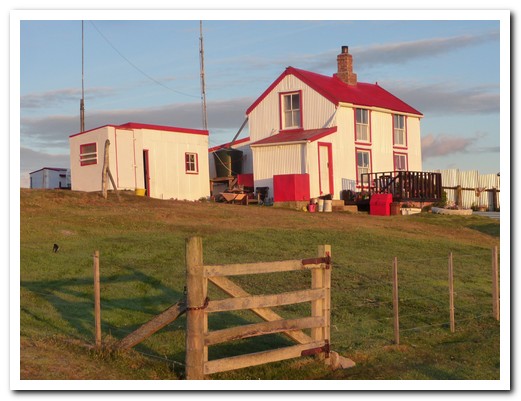
The Wardens Hut at Volunteer Point
Sea Lion Island
08th February 2010
Before the plane could land on Saunders Island to take us to Sea Lion Island, we had to chase the geese off the gravel landing strip in a 4×4.
.
The wind sock was horizontal across the strip as we took off, only to land again 15 minutes later on Carcass Island to drop off 2 passengers. Next we landed at Pebble Island for more passengers, then a quick stop at Stanley airport and on to Sea Lion Island. (Map of Falklands)
.
Jeff enjoyed himself in the copilots seat (he had flown a similar aircraft some 40 years earlier).
.
Sea Lion Island is home to Sea Lions and Elephant Seals as well as Penguins and many birds. Because the sheep have been removed, the tussock grass has covered large parts of the island, giving protection to the smaller birds. We managed to cover the island on foot until gale force winds and rain forced us inside.
.

Jeff is not flying the plane

The original farm house on the Island was made from a ship wreck

Ruddy Headed Goose

A pair of Steamer Ducks in the kelp
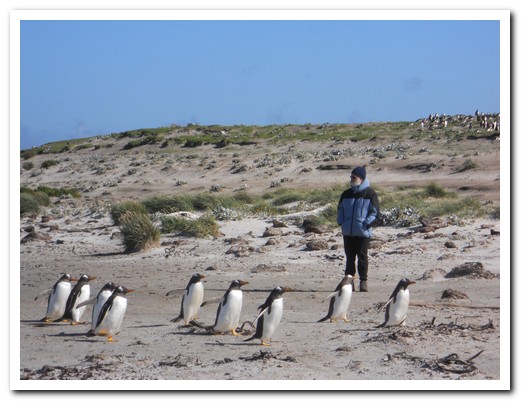
Gentoos making their way back to their nests

Gentoo baby is getting a bit too big

Gentoos

Magallans nest in the Tussock Grass

Oyster Catcher feeding

Skua with chick

A vagrant King hunched against the wind

A pair of Upland Geese

Male Upland

Female Upland

Baby geese

Baby Rockhopper Penguins in gale force winds

Old Rockhopper nests

Rockhopper eyebrows in the wind
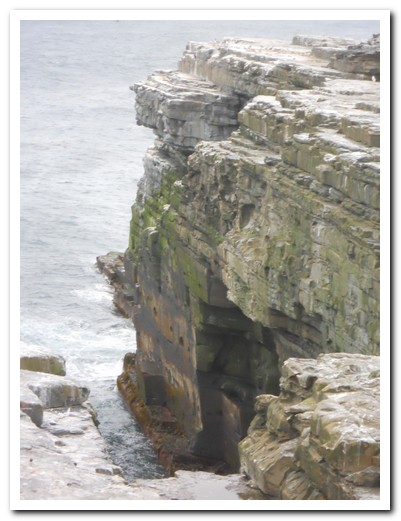
The Rockhoppers go down and up every day
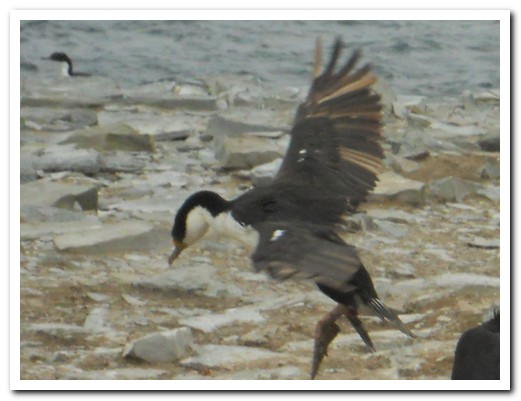
Cormorant trying to land in 50 knot winds

Magallan Snipe blends in

Male Elephant Seal .....

... yawning

Eyeing a birdie

Yum

This one was moulting

Sea Lion playing with her pups
Saunders Island
07th February 2010
Because we didn´t see King Penguins in Antarctica, we decided to fly to the Falkland Islands to try our luck. The treeless, windswept landscape reminded us of northern Scotland.
.
Our first night was at Darwin Settlement (population 5) where we enjoyed a delicious home cooked meal.
.
The following day we flew in a 7 passenger Islander aircraft to Saunders Island (population 7) with strong gusty winds blowing. We were driven to the other side of the island by 4 wheel drive and left alone for a 2 day stay in a little self catering cottage to enjoy the wildlife.
.
We were not disappointed. Our first King Penguin was a vagrant, towering over a group of Magellans. On a clifftop walk, we spotted hundreds of Black Browed Albatross (wing span 2 metres) soaring overhead, and on closer inspection discovered fluffy fat chicks perched on exposed nests, waiting for a feed.
.
Further along was a huge colony of Rockhopper Penguins with curious tufts of hair on their heads. They were also returning to their nests with food for their fluffy brown chicks. We spent all day exploring the rugged coastline, teeming with wildlife and we had it all to ourselves. Dinner was a lamb stew that we made from ingredients bought at the farm.
.

.
.
.

Darwin House where we spent our first night

We made 7 flights in the Islander hopping between the islands

Saunders Island from the air

Rock Cormorants - mother and chick, plus egg

The isolated self catering hut at The Rookery

Magellan Penguin with moulting chick, near their burrows

Magallan Penguins on the beach

Coming ashore

Sea Cabbage growing on the sand dunes

The King Penguin with his little followers (Magellans)

Steamer Duck
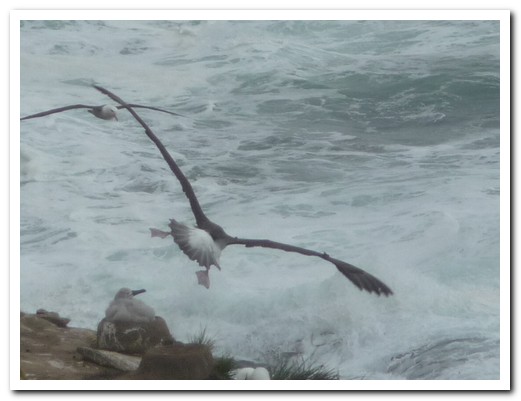
Albatross - landing gear down

Black Browed Albatross

The coastline of Saunders Island

Albatross & chick on mud nest

Albatross taking advantage of the strong winds to soar

King Cormorant

A pair of Kelp Geese

Rockhopper


Rockhopper with chick
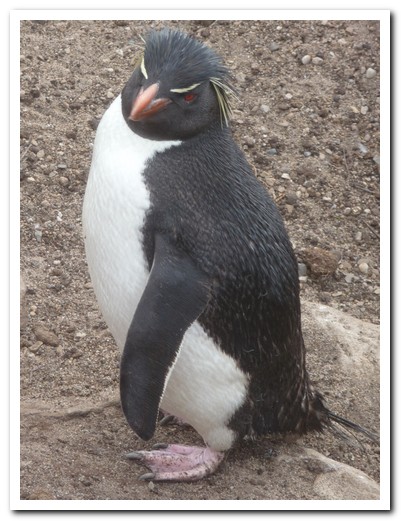


Sheep and penguins live happily together

One of the stone corrals left from gaucho days

Saunders farm house